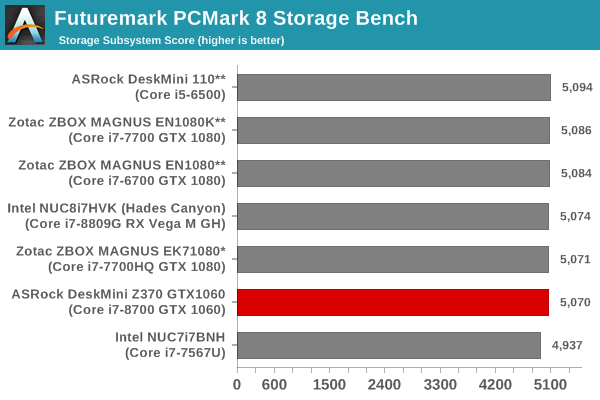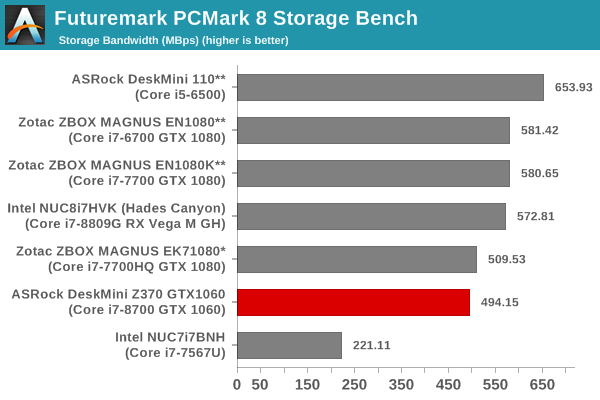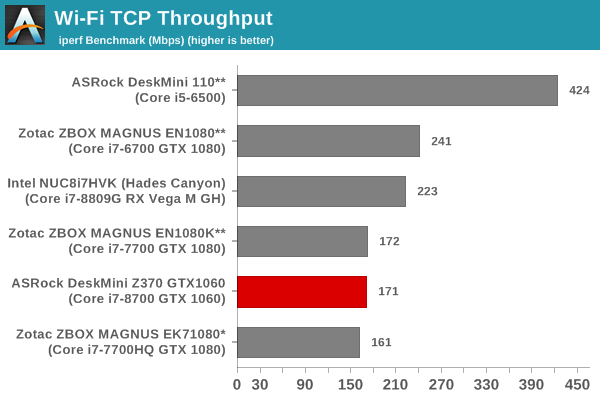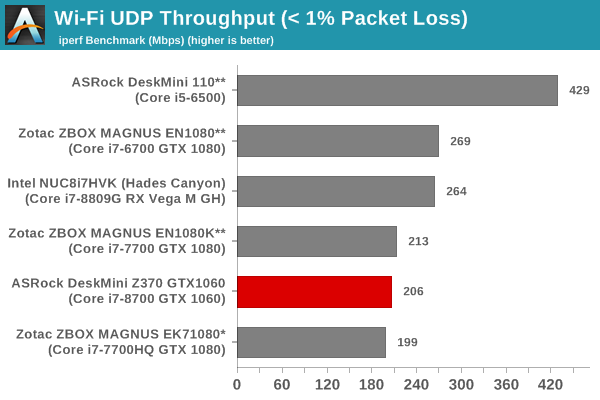ASRock DeskMini Z370 GTX1060 Review: A Compact Coffee Lake Gaming PC
by Ganesh T S on June 12, 2018 10:00 AM ESTNetworking and Storage Performance
Networking and storage are two major aspects which influence our experience with any computing system. This section presents results from our evaluation of these aspects in the ASRock DeskMini Z370 GTX1060. On the storage side, one option would be repetition of our strenuous SSD review tests on the drive(s) in the PC. Fortunately, to avoid that overkill, PCMark 8 has a storage bench where certain common workloads such as loading games and document processing are replayed on the target drive. Results are presented in two forms, one being a benchmark number and the other, a bandwidth figure. We ran the PCMark 8 storage bench on selected PCs and the results are presented below.


Almost all the systems scoring higher than the DeskMini Z370 have scores not impacted by the Spectre / Meltdown patches. Only the Hades Canyon NUC is better with the same patch status as the DeskMini Z370. This makes sense, given the responsiveness of the Optane stick in the NUC compared to the MLC NVMe SSD in the DeskMini Z370 GTX1060.
On the networking side, we restricted ourselves to the evaluation of the WLAN component. Our standard test router is the Netgear R7000 Nighthawk configured with both 2.4 GHz and 5 GHz networks. The router is placed approximately 20 ft. away, separated by a drywall (as in a typical US building). A wired client is connected to the R7000 and serves as one endpoint for iperf evaluation. The PC under test is made to connect to either the 5 GHz (preferred) or 2.4 GHz SSID and iperf tests are conducted for both TCP and UDP transfers. It is ensured that the PC under test is the only wireless client for the Netgear R7000. We evaluate total throughput for up to 32 simultaneous TCP connections using iperf and present the highest number in the graph below.

In the UDP case, we try to transfer data at the highest rate possible for which we get less than 1% packet loss.

The 1x1 solution (AC3165) performs as expected, similar to the other 1x1 solutions in the Zotac PCs. Moving up the benchmark graphs requires a more capable WLAN module, a cost that ASRock understandably not want in this gaming-focused system. In any case, the WLAN module is easily replaceable, if the user needs better performance in this segment.










20 Comments
View All Comments
DanNeely - Tuesday, June 12, 2018 - link
sadly the fly in the ointment for something like this is that MXM cards are still really hard to find and sold at major markups vs standard desktop cards.Great idea in the abstract, but unless part availability ever improves still only barely upgradable in the real world.
Samus - Thursday, June 14, 2018 - link
I couldn’t agree more. If ASRock could commit to end user upgradability with MXM’s for the next gen GPU’s, this would be attractive, but as it is, this is a mostly disposable gaming PC in 3 years when it will be 2 generations behind in the GPU world and no longer able to run the then-current games at decent quality. A tough sell for a $1300 PC, even tougher when you consider a laptop (which naturally includes a screen) sells for the same price at the same spec as this machine...milkod2001 - Monday, June 18, 2018 - link
Good point with laptop at the same price.stuffwhy - Tuesday, June 12, 2018 - link
New to this aspect of HTPC. The protected AV path for UltraHD playback - it's striking me as rare. Is there currently a particularly limited availability of capable PC hardware? or is it up to some manufacturer, such as GPU maker, to just implement and they don't?ganeshts - Tuesday, June 12, 2018 - link
You can find additional details about the 'Advanced Protected Audio/Video Path' here: https://www.anandtech.com/show/12171/a-budget-home...milkywayer - Tuesday, June 12, 2018 - link
Too expensive anyway. There are many cheaper ways to build an SFF machine without paying a premium. Get a Louqe Ghost or Dan Case A4 off of ebay and buy the cpu + MoBo bundle off of micro center for $30 off. Get a Sf600 sfx psu and you're all set for 70% the price with much better looking cases.Samus - Thursday, June 14, 2018 - link
It’s true, you could totally build a similar spec PC with an upgradable 10.5” PCIe GPU for a bit less, albeit adding some volume. It would still be less than a cu ft...so really negligible when you consider the PSU (SFX) would be integrated...linkman10 - Friday, June 15, 2018 - link
One can almost always save a substantial amount of money by building their own PC. These are targeted at those that don't want the hassle of planning, sourcing, and assembling on their own (or don't know how -- which is the majority of the population) and then troubleshooting any build problems.cosmotic - Tuesday, June 12, 2018 - link
Where are the Zotac EN970, EN1070K and EN1060K?eva02langley - Tuesday, June 12, 2018 - link
The problem with MXM cards is that every one of them is a custom design made for a specific PCB. I wanted to switch my ATI radeon HD 5850 mobile with a 1050 GTX mobile on MXM format. The TDP was the same and I was expecting this to be a fairly easy swap. Until I made some further research on the matter, I understood it was quite the opposite, if not impossible to do so. The only thing I had to change on my laptop was the GPU, however you cannot do it with laptops.So, for me, MXM cards, is something I don`t really back. Unless the industry is making it a standard and work toward a possible upgrade path for users, I don`t see this becoming relevant.
Sure the form factor is great, but everything else is horrible.